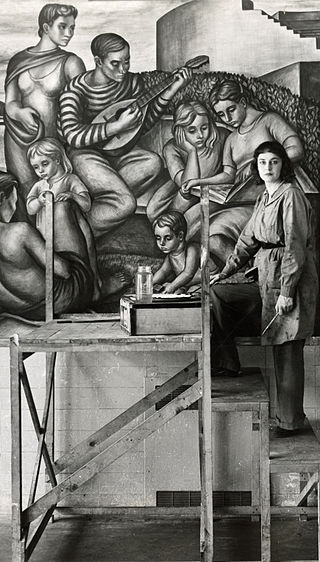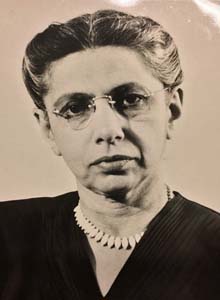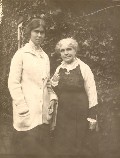Karla Woisnitza | |
|---|---|
 portrait by Simone Kornfeld, 2019 | |
| Born | 16 August 1952 |
| Nationality | German |
| Education | Dresden Academy of Fine Arts |
Karla Woisnitza (born 16 August 1952) is a German artist.
Karla Woisnitza | |
|---|---|
 portrait by Simone Kornfeld, 2019 | |
| Born | 16 August 1952 |
| Nationality | German |
| Education | Dresden Academy of Fine Arts |
Karla Woisnitza (born 16 August 1952) is a German artist.
Woisnitza was born in Rüdersdorf. Before she went to art school, she took part in a drawing group in her hometown led by the artist Erika Stürmer-Alex. She studied set design from 1973 to 1979 at the Dresden Academy of Fine Arts. In her core curriculum, she studied with Günter Hornig, who was an inspiration to a number of influential performance artists in East Germany [1] and who gave his students room for creative experimentation despite the conservative climate of the academy. [2] During her studies, Woisnitza brought together women artists and founded loose networks. [1] These included her fellow students and upcoming artists like Christine Schlegel, Marie-Luise Bauerschmidt, Sabine Gumnitz, Monika Hanske, Cornelia Schleime, and Angela Schumann. They realized a number of collective events together. [1] These informal performances involved body actions, such as Face Painting Action (Gesichts-malaktion, 1978–1979). [2]
In 1991, Woisnitza received a diploma in painting and graphic design from the Academy.
In 1992, she received the Marianne Werefkin Prize from the Berlin Women Artist Association. From 1993 to 1995, she painted seven large frescoes for the Virchow-Klinikum campus of the Charité hospital in Berlin. In 1994, Woisnitza received the Käthe Kollwitz Prize from the Berlin Academy of Arts. In 2002, she created a fresco for the church hall of the Evangelical church in Rüdersdorf. [3]
Woisnitza was encouraged by two artist/teachers, Gunther Hornig and Erika Sturmer-Alex to do non-conformist conceptual art. She developed "an artistic activation of the body in the interest of female self-assurance and empowerment" [2] and would call "into question traditional representations of femininity as well as the basic difference between internal and external perception." [2]
Woisnitza's work is in the National Museum of Women in the Arts. [4]

Joan Jonas is an American visual artist and a pioneer of video and performance art, "a central figure in the performance art movement of the late 1960s". Jonas' projects and experiments were influential in the creation of video performance art as a medium. Her influences also extended to conceptual art, theatre, performance art and other visual media. She lives and works in New York and Nova Scotia, Canada.
Dame Sonia Dawn Boyce is a British Afro-Caribbean artist and educator who lives and works in London. She is a Professor of Black Art and Design at University of the Arts London. Boyce's research interests explore art as a social practice and the critical and contextual debates that arise from this area of study. Boyce has been closely collaborating with other artists since 1990 with a focus on collaborative work, frequently involving improvisation and unplanned performative actions on the part of her collaborators. Boyce's work involves a variety of media, such as drawing, print, photography, video, and sound. Her art explores "the relationship between sound and memory, the dynamics of space, and incorporating the spectator". To date, Boyce has taught Fine Art studio practice for more than 30 years in several art colleges across the UK.

Yvonne Helene Jacquette was an American painter, printmaker, and educator. She was known in particular for her depictions of aerial landscapes, especially her low-altitude and oblique aerial views of cities or towns, often painted using a distinctive, pointillistic technique. Through her marriage with Rudy Burckhardt, she was a member of the Burckhardt family by marriage. Her son is Tom Burckhardt.

Rolf Aamot was a Norwegian painter, film director, photographer and tonal-image composer. Since the 1950s, Aamot has been a pioneer within the field of electronic painting, exploring the emerging technology as it combines with the traditional arts of painting, music, film, theatre, and ballet. Aamot studied painting at the Oslo National Academy of the Arts, and film at Dramatiska Institutet in Stockholm. Aamot is known for his work as a painter, electronic painter, art photographer, graphic artist, film director, tonal-image composer and cultural author.

Alexandre Yevgenievich Jacovleff was a neoclassicist painter, draughtsman, designer and etcher.

Débora Arango Pérez was a Colombian artist, born in Medellín, Colombia as the daughter of Castor María Arango Díaz and Elvira Pérez. Though she was primarily a painter, Arango also worked in other media, such as ceramics and graphic art. Throughout her career, Arango used her artwork to explore many politically charged and controversial issues, her subjects ranging from nude women to the role of the Roman Catholic Church to dictatorships.

Marion Kathryn Greenwood was an American social realist artist who became popular starting in the 1920s and became renowned in both the United States and Mexico. She is most well known for her murals, but she also practiced easel painting, printmaking, and frescoes.

Eugenia Berlin (1905–2003) was a Russian Empire-born Canadian sculptor, painter, designer and director.

Hilda Belcher was an American artist known for her paintings, watercolors, portraits, and illustrations depicting individuals and landscapes, both in formal portraiture and in casual scenes of children and daily life. She was the second woman to be accepted into the National Academy of Design. In 1935, Anne Miller Downes, a reviewer for The New York Times, called Belcher was "one of the most distinguished women artists in America".

Howardena Pindell is an American artist, curator, critic, and educator. She is known as a painter and mixed media artist who uses a wide variety of techniques and materials. She began her long arts career working with the New York Museum of Modern Art, while making work at night. She co-founded the A.I.R. gallery and worked with other groups to advocate for herself and other female artists, Black women in particular. Her work explores texture, color, structures, and the process of making art; it is often political, addressing the intersecting issues of racism, feminism, violence, slavery, and exploitation. She has created abstract paintings, collages, "video drawings," and "process art" and has exhibited around the world.

Jennie Augusta Brownscombe was an American painter, designer, etcher, commercial artist, and illustrator. Brownscombe studied art for years in the United States and in Paris. She was a founding member, student and teacher at the Art Students League of New York. She made genre paintings, including revolutionary and colonial American history, most notably The First Thanksgiving held at Pilgrim Hall in Plymouth, Massachusetts. She sold the reproduction rights to more than 100 paintings, and images of her work have appeared on prints, calendars and greeting cards. Her works are in many public collections and museums. In 1899 she was described by New York World as "one of America's best artists."

Paulina Olowska is a Polish painter and photographer, who also works in the field of performance and video-art, social action and applied art. The areas of her artistic explorations are modernist utopias and research on the work of 20th century artists, which she combines with her own creative practice to bring unjustly forgotten ideas back to life. A characteristic thread in Olowska's work is her interest in female attitudes in art and her search for "protoplasts"; such as Alina Szapocznikow and Zofia Stryjeńska. The artist lives and works in Rabka-Zdrój.

The Käthe Kollwitz Prize is a German art award named after artist Käthe Kollwitz.

Nan Hoover was a Dutch/American-expatriate artist who is known for her pioneering work in video art, photography and performance art. She spent almost four decades living and working in the Netherlands. She also used the mediums of drawing, painting, photography and film and created art objects and sculptures. One of the main themes of her art was light and motion. The rigorous, minimalist handling of her means as well as the intense concentration with which she performed within spaces of light and shadow are the most salient characteristics of her artistic work.

Ilona Keserü is a Hungarian painter, professor emerita, Kossuth Prize winner.

Erika Stürmer-Alex is a German artist whose works include wall paintings, panel paintings, printed graphics, collage sculptures, polyester sculptures and installations.
Gisela Weimann is a German multimedia artist who lives and works in Berlin. Her working techniques range from painting, printmaking, photography, sculpture and film to performance art and art in public spaces. She has also written and published several books and essays about her own work, art collaborations and art history topics. Her work often focuses on political — particularly feminist — themes and on the relationship of art with political and social issues.

Sarah Jane Blakeslee was an American landscape and portrait painter.

Cornelia Schleime is a German painter, performer, filmmaker and author. Born in East Berlin under the GDR, she studied painting and graphic arts at the Dresden Academy of Fine Arts before becoming a member of the underground art scene.
The Verein der Berliner Künstlerinnen is the oldest existing association of women artists in Germany. It maintains the archive Verein der Berliner Künstlerinnen 1867 e. V., publishes club announcements and catalogues, and every two years awards the Marianne Werefkin Prize to contemporary female artists. It thus cultivates cultural memory and promotes the current developments of contemporary artists. The 2007 award winner was the sculptor Paloma Varga Weisz.
{{cite book}}: CS1 maint: others (link)